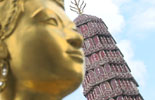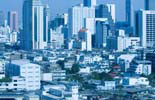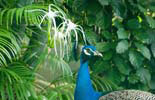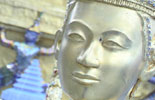 |
 |
 |
Thailand
Wat Phra Keo, the King's Grand Palace in Bangkok, with its famed Emerald Buddha sculpture, provides a haunting window on the challenges facing Thai ecologists. Near this epicenter of international and domestic Buddhist pilgrimage is the Chactuchak Market, notorious for being a center of the illegal wildlife trade.
While there are nearly 409 protected areas in Thailand, representing approximately 20% of the country's terrestrial extent, the number of Threatened species is very high. Of the 302 known species of mammal, for example, at least 37 are in trouble. Rapid development in the country has long been viewed as one of the great international biodiversity emergencies. Along with China, Thailand proffers a vision of stereotypical runaway Asian consumerism, as they rush to catch up with the Western model. As of 1987, no large wild mammal has survived outside a national park in Thailand.
Yet, another vision also hovers about Thai life that can be gleaned from the remarkable spirit and artistic array of Wat Phra Keo. Here are reminders of traditional Thai Buddhist life so steeped in reverence for the natural world. Such cultural and economic conflicts, emblematic of the ambiguities of the 19th through 21st centuries, could provide critical wake-up calls. Wat Phra Keo offers the opportunity for recognition of our ability as a species to focus on wildness and to celebrate the beauty and sacredness of the natural world. This precious place is celebrated in the book Sanctuary.
Wat Phra Keo, the King's Grand Palace
http://www.thailandguidebook.com/palace1.html
http://www.sacred-destinations.com/thailand
/bangkok-wat-phra-keo-temple-of-emerald-buddha.htm
http://thailandforvisitors.com/central/bangkok/
ratanakosin/prakeo/green/
 |
 |
|
 |
 |

